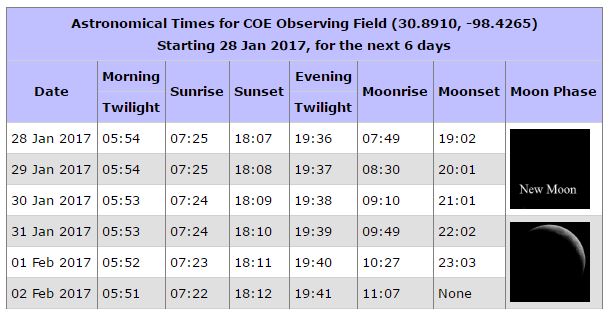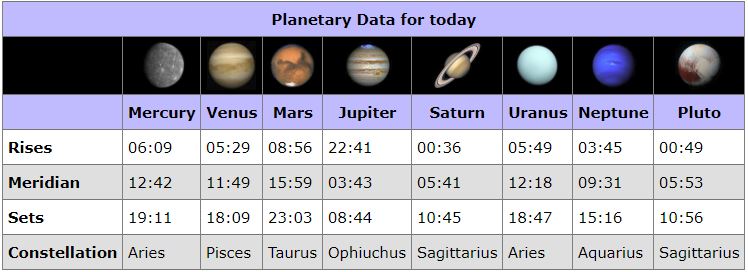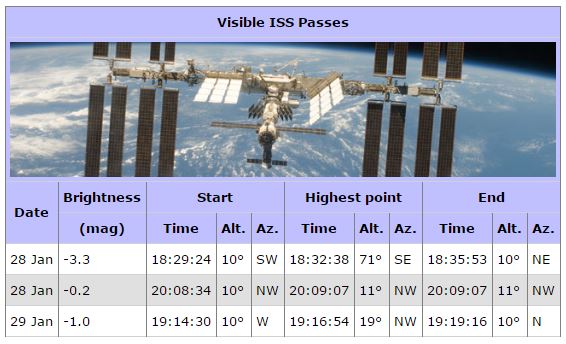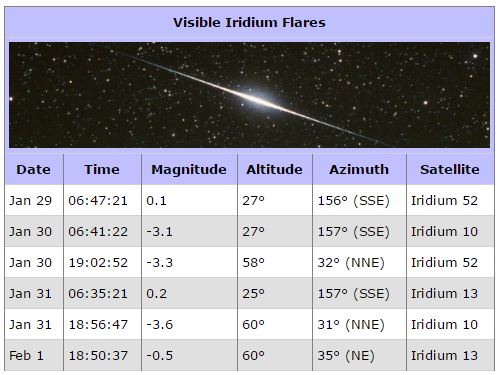
Stars-at-night displays astronomical data for a specified location and date.
| Author: | Sean Leary (profile at wordpress.org) |
| WordPress version required: | 4.6 |
| WordPress version tested: | 5.8.1 |
| Plugin version: | 1.9.1 |
| Added to WordPress repository: | 11-12-2016 |
| Last updated: | 11-09-2021
Warning! This plugin has not been updated in over 2 years. It may no longer be maintained or supported and may have compatibility issues when used with more recent versions of WordPress.
|
| Rating, %: | 100 |
| Rated by: | 3 |
| Plugin URI: | https://github.com/stleary/stars-at-night |
| Total downloads: | 5 291 |
| Active installs: | 200+ |
 Click to start download |
|
This plugin displays data of interest to amateur astronomers. It is calculated from user-provided location and date information.
The plugin is called from a WordPress shortcode, and the parameters are specified in the shortcode. The following parameters are
required, in any order:
- lat : Lattitude of location in fractional degrees (e.g. 30.8910). Positive is north, negative is south of equator
- long : Longitude of location in fractional degrees (e.g.-98.4265). Positive is east, negative is west of the UTC line
- timezone : Timezone name, must be value recognized by PHP. See http://php.net/manual/en/timezones.php
These parameters are optional:
- name : The name of the location to be calculated
- days : The number of days of data to display. Must be a value from 1 to 10. Defaults to 3 if not specified.
Shortcode Examples:
- stars-at-night name=Chennai lat=13.08 long=80.26 timezone=Asia/Kolkata days=1
- stars-at-night name=”COE Observing Field” lat=30.891 long=-97.4265 timezone=America/Chicago days=10
You can also display the individual data tables via more specific shortcodes:
- stars-at-night-sun-moon name=”Mount Kilimanjaro” lat=-2.55 long=37.55 timezone=Africa/Nairobi
- stars-at-night-planets name=”Ushuaia” lat=-54.8 long=-68.33 timezone=America/Argentina/Ushuaia
- stars-at-night-iss name=”Mount Burnett Observatory” lat=-37.9 long=145.4 timezone=Australia/Melbourne days=7
The output consists of simple HTML tables:
- Sun/Moon table: The times for sunrise, sunset, moonrise, moonset, morning astronomical twilight, and evening astronomical twilight for the specified days (max 10 days).
- Planets table: The times and visibility for the planets, for the current day.
- ISS table: The times and directions for visible ISS passes over the specified days (max 10 days).
- (REMOVED) Iridium flares table: The times and directions for visible Iridium flares over the specified days (max 7 days).
You can view the plugin in action here: http://johnjleary.com/notforlong
Credits and Acknowledgements:
- Lunar images by Dan Morgan. Used with permission. http://DanMorgan.org.
- WordPress framework and sunrise/sunset algorithm: https://github.com/bengreeley/sunrisesunset
- Moonrise and Moonset class (with a correction for timezone): http://dxprog.com/entry/calculate-moon-rise-and-set-in-php
- Moon phase class: https://github.com/solarissmoke/php-moon-phase
- Planetary, ISS and Iridium Flare tables are obtained by sending GET requests to: http://heavens-above.com (HTTP API used with permission)
- Per-table shortcodes implemented by Peter Lieverdink
Contributors
stleary
Peter Lieverdink
Screenshots
FAQ
ChangeLog




